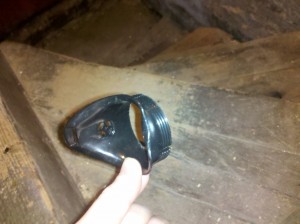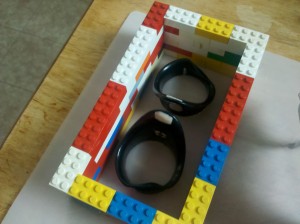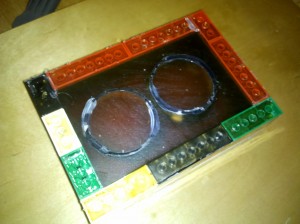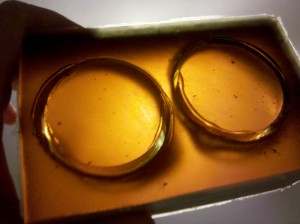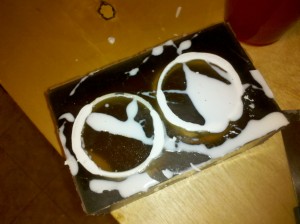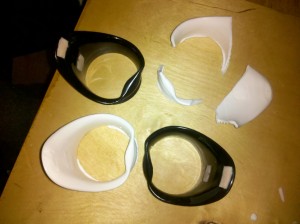(Mis-)Adventures with Composimold
After hearing about Composimold, I decided to give it a try. It took a little getting used to, but this reusable thermoplastic urethane turns out to be just what the doctor ordered for ease-of-use. I didn't want to try anything really tricky for the experimental mold-making batch, so I gave it a shot with a pair of safety goggles I had lying around.
I had a pair of safety goggles sitting around to play with. The goggle parts have threads and nice thin walls which should pose a little bit of a challenge for the stuff for a shakedown. The parts had a couple of holes where the ventilation goes, and the strap and nosebridge, so I filled those with some Sculpey. Partly this was to prevent the mold from locking the part inside, but also this was because I saw this as a chance to fix some of the aesthetic problems I've always had with these goggles.
I dutifully built a mold barrier out of Lego bricks, and hot-glued the goggle-parts into place on a thin piece of nylon mat that I frequently used for making silicone molds, along with the Lego barrier.Composimold melts in the microwave, so while I let that happen, I gave the parts and the inside of the barrier a gentle coating of silicone lubricant for use as mold release agent. The pour began rather beautifully - very few air bubbles, and no significant problems, until a few seconds in. The thin nylon mat I'd been using was not happy about having lots of very hot stuff dumped on it, and decided to warp in protest. The mat pulled away from the Lego, causing a massive leak all over my kitchen table and onto my floor.
Well, after some swearing, I took the opportunity to test the reusability of the product. Despite not having mold-release all over my kitchen, after an hour or two of letting the stuff cool off, it peeled up neatly from most everywhere - but I'm really glad I don't own a kitchen rug or something. A quick trip to the basement yielded a smooth plywood board, and it was time for a second attempt. This time, all seemed well, until it came time to de-mold. As it turns out, the high viscosity of the product will not keep it from leaking through the very small gaps between Lego bricks. This wouldn't be a terrible problem ordinarily, except that the very small loss all around the mold caused enough loss to have the very top of the parts sticking out of the mold when it solidified, rendering it unusable. Grrr. This sort of thing doesn't happen with silicone. But then again, I wouldn't be able to try again for free with silicone, so you win some and you lose some.
Armed with these lessons, I tried a third time. This time I lined the inside of the mold-barrier with gaffer's tape, and the mold came out fabulously. A few minutes of diassembly of the Lego, and cleaning the urethane out of the undersides, and and I had a nice stretchy rubbery block with two goggle-parts embedded within.
Thanks to the application of silicone spray, de-molding the originals went pretty easily. I was able to physically jam my finger inside and hook the part and just yank. It came free without much complaint or argument, and left me with a nice mold. There were lots of extremely tiny bubbles that had stayed on the surface of the goggle-parts during molding, but at worst those would cause surface roughness in a cast part, and not big ugly nodules. After getting this far, I really couldn't wait to try a cast!
I mixed up what I thought was a small but adequate batch of Smooth-Cast 300 and carefully poured it into the mold. As it turns out, I mixed entirely too much of the stuff - about three or four times what I actually needed. It's a shame, and entirely avoidable. I could easily have estimated the appropriate amount with some water and a measuring cup. I was rushing because I was excited, and that's when I make mistakes. When the cast cured, it was time to de-mold.
Of course, that's when I realized I'd completely forgotten to put mold-release agent inside the mold before pouring the SC-300. The trouble with that is that SC-300 is a urethane product just like the Composimold is, and incidentally just like Gorilla Glue. This made de-molding much more difficult than the first time around. I wound up snapping one of the parts into three pieces. I didn't have to cut the mold away or anything like that though, but I'll chalk that up to residual silicone spray in the mold cavity. A little cyanoacrylate adhesive fixed the broken part up very nicely.
Now to figure out what to do with two spare white goggle-parts! That will have to be another project entirely, I think.
